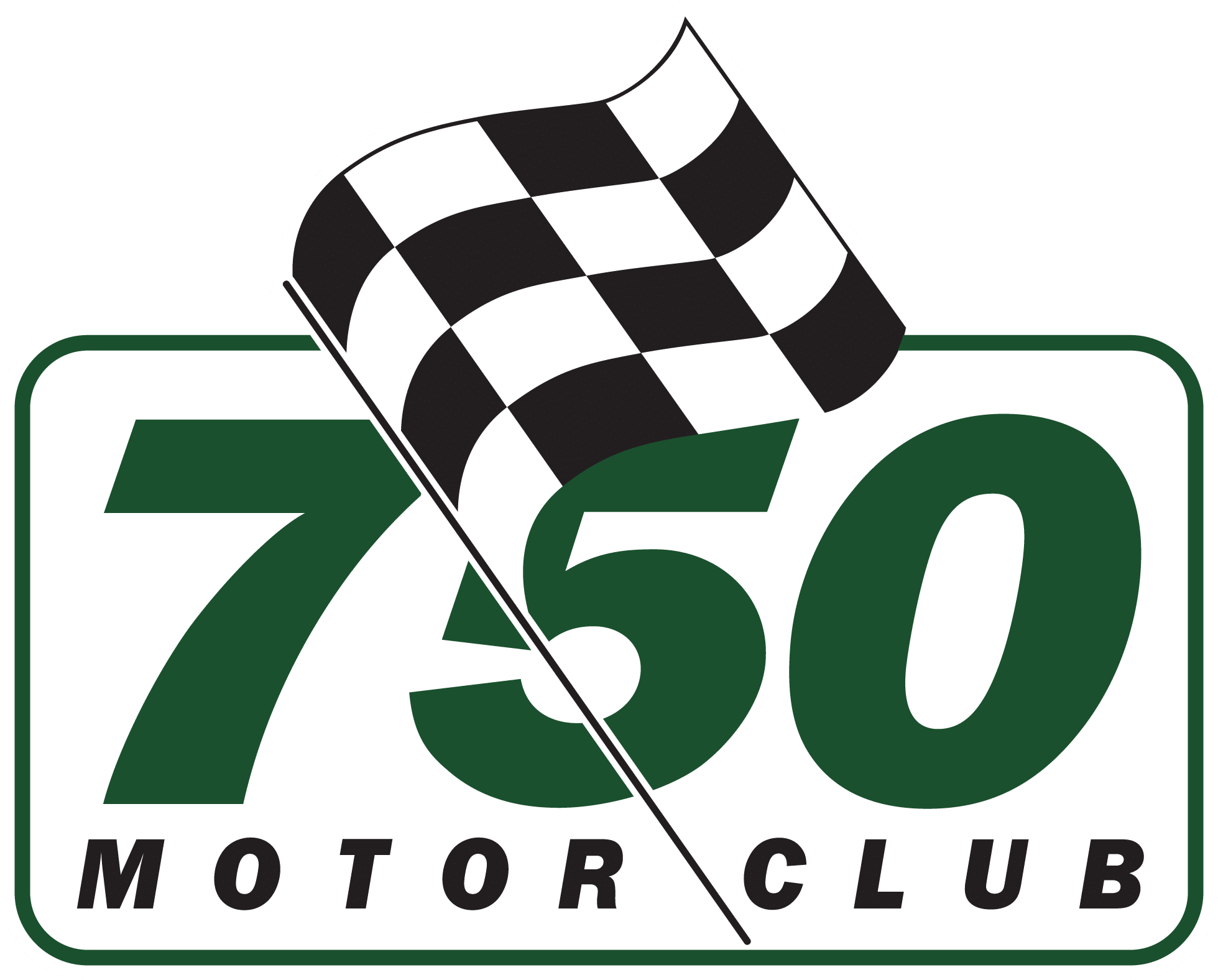Where Motorsport Began
The 750 Motor Club was formed in 1939 as a means for ‘the impecunious Austin Seven enthusiast’ to meet like-minded individuals and talk about things Seven-ish and motoring related. It wasn’t long before such discussions led to the notion of competition, but for the financially-challenged membership these proposed ‘races’ naturally had to involve an extremely small outlay.
Such competition therefore initially took the form of road rallies and trials, although the ‘specials’ builder was already in evidence at circuit meetings, with both mildly and heavily modified Austin Sevens.
Post-War Expansion
The outbreak of WWII brought all forms of motorsport to halt, but the 750 Motor Club continued to meet at pubs in the London area, albeit with most of the membership arriving on bicycles.
After the war, the Club continued to grow under the leadership of chairman Holly Birkett who, in 1949 was to come up with three ideas that were to have quite an influence on motorsport at the more affordable end of the scale. One of these helped launch the Club nationwide and allowed expansion into self-run meetings, whilst the other two still remain equally popular each season to this day.
Firstly, Holly came up with the proposal of a 750 Formula, a two seater sports-racing car powered by the 750cc Austin Seven engine and based around the Seven chassis. This provided an outlet for the skills of the home constructor and special builder, and a number of now well known figures in international motorsport cut their teeth as 750 Motor Club members in this golden era of ingenuity.
Perhaps the most famous of these was Colin Chapman, whose innovative interpretation of the regulations allowed him to blitz the opposition various times in competition. After a number of Austin Seven Specials, his first re-titled ‘Lotus Mk1’ was a 750MC Sporting Trials car, with every single Lotus road model to-date in the Chapman and post-Chapman era going on to compete with 750 Motor Club.
750 Formula is still thriving today and is the longest running championship in the world – older than Formula 1. Now on its third generation of engine (Fiat 1100cc FIRE) as supplies of Austin and second-generation Reliant engines started to diminish, the previous two generations of Reliant-powered and Austin Seven-based 750 Formula cars still race today in our Historic 750 Formula.
Various new formulae have been developed and introduced over the years and these days more than 25 series and championship are now available, from Formula Vee single seaters, to Locost Racing, a Hot Hatch Championship and Club Enduro.
As well as the ensuring the highest quality experience with the largest grids and friendliest paddock, the focus still remains on leading the way in terms of affordable motorsport, whether via capitalising on an affordable new model, or investing in our own mobile rolling road to pioneer a switch to power-to-weight classes rather than capacity, and reduce competitor spending as a result.
Holly’s second idea was for a Six-Hour Relay Race. Running continuously since 1951 and still titled as the ‘Birkett Six-Hour Relay Race’, Holly’s masterstroke was the handicap format that allowed every team to have a chance of winning. Whilst there is still a ‘Scratch’ winner overall, the handicap element ensures that teams can be as varied as possible and enter ANY closed-wheel car.
Often described as ‘the last bastion of British motorsport’, typical Birkett race photos have included everything from an Austin A30 going wheel-to-wheel with a TCR Touring car, teams of Smart cars battling Caterhams, or a Jaguar XJS trying to hunt down a Mini.
Holly’s final idea was for a consortium of the smaller motoring clubs to group together and organise a race meeting at Silverstone, which up until then was the sole preserve of the bigger and longer established organisations.
This ‘Eight Club’s event proved successful, and in the years that followed 750MC went on to organise and run all its own race meetings. These days the Club typically organises 25-30 racedays across 15-20 separate 750 Motor Club events from the office HQ at Donington Park.
Roll of Honour
Since it was founded in 1939, 750 Motor Club has always attracted aspiring engineers and innovators who have used their skills to develop new ideas for car and engine design.
From Lotus and Chevron to Noble and Radical, over the years a number of the members have ‘graduated’ and gone on to build constructors and/or make a name for themselves in the motorsport business.
| Name | Achievement |
|---|---|
| Adrian Reynard | Reynard Racing founder: FF1600, FF2000, F3, F3000, CART winners, and a recent racing returnee in a self-developed Radical. A current Vice President of 750MC. |
| Arthur Mallock | Founder of Mallock Racing, the foremost manufacturer of F1300 and Clubmans cars. |
| Eric Broadley | Founder of Lola and designed the GT40 that devastated the Ferraris at Le Mans in the late sixties. Won the Indycar Championship in 1993 with Nigel Mansell at the wheel. |
| Colin Chapman | Founder of Lotus; with countless cars and innovations, from early Club success to F1 and iconic road cars. |
| Derek Bennett | Founder of Chevron Cars, from sports cars to F1. |
| John Miles | Former Team Lotus F1 driver, sportscar champion, esteemed road tester and vehicle dynamics guru. John cut his racing and engineering teeth with an Austin Seven and 750MC, remaining close to the Club until his passing in 2018. ‘The John Miles Young Driver Award’ continues in his memory. |
| Tony Southgate | 750MC’s current President, he designed the Jaguar XJRs that won Le Mans in 1988. His work includes Group C Toyotas, Ferrari 333SP, Lister Storm, Yardley-BRM, Shadow GP car, Arrows, and Lotus. |
| Brian Hart | Learnt his trade building and racing an 1172 Formula special in 750 Motor Club, before going on to design and build F1 engines. |
| Gordon Murray | Legendary F1 designer, responsible for Brabham cars in the 1970s and early ’80s. Later designed the Rocket and the McLaren F1, which won Le Mans in GTR form. |
| Lee Noble | Designer of Ultima and Noble Sportscars, the early models of which were raced in the 750MC Kit Car Championship. |
| Jem Marsh | Founder of Marcos Cars, whose 600LM became a formidable GT race car. |
| Frank Costin | Joint founder of Marcos. Aerodynamicist behind the Vanwall, responsible for several iconic 1960s designs. Brother of Mike Costin, co-founder of Cosworth Engineering. |
| Mike Pilbeam | Worked for Lotus, Surtees, and BRM before founding Pilbeam Racing Designs in 1975. His cars continue to dominate hillclimbs. |
| Phil Abbott & Mick Hyde | Founders of Radical Sportscars; their early models were developed for 750 Motor Club Championships and driven by the duo. |
| Club President | Tony Southgate |
| Vice Presidents | Viv Ayres, Ian Nelson, Robin Knight, Keith Messer, Marcus Pye, Adrian Reynard, Mike Whatley |





